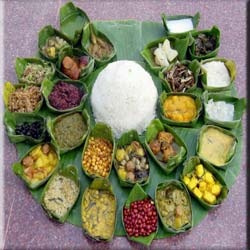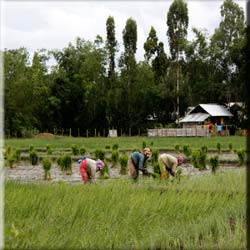CULTURE IS THE ART OF LIVING
The People of Manipur are popularly known as Manipuris and they fall under two main classes namely the Bishnupriyas and the Meiteis. Apart from these two main classes the land is inhibited by numerous tribes. It is believed that the Bishnupriyas are Indo Aryans belonging to the Kshatriyas and are firm by origin. They actually descended from the Aryan invaders who during the pre- Christian era passed through the hilly area of Manipur. The features of these ethnic people are very sharp resembling exactly to that of the Indo Aryans. Unlike the other racial groups of the North-east region of the country, the people of Manipur or the Manipuris are tall and physically strong by nature.
The culture of MANIPUR can be best expressed as comprising the following : ORIGIN AND ETHNICITY
Though the Meiteis are believed to be the Kuki-Chin branch of the Mongolians, there are also other controversies regarding their origin. There are theories which states that the Meiteis are Aryans by origin or they are the descendants of Arjuna of Mahabharata. The valleys of Manipur are dominated by Bishnupriyas, Meiteis, Pangal, and "Bhamons" whereas the hilly areas of the state are occupied by the Naga, Kuki, and smaller tribal communities. The ethnicity of Manipur shows that there are a number of ethnic groups inhabiting the state but still all are of the same Mongoloid group where almost all their cultural and traditional features are similar. The Manipuris are broadly classified into three major communities namely the Meiteis who occupy the valleys of Manipur and two major tribal groups namely the Nags and Kuki-Chins.The Bamon and the Pangans are grouped under the Meiteis. The common language widely spoken by the people of Manipur is Manipuri. The Naga group of tribal includes Zeliangrong, Rongmei or Kabui, and Liangmei and Zemei or Kacha Nagas, Tangkhul, Mao, Maram, Maring and Tarao. CULTURE
Manipuris takes the pride of a rich cultural heritage. The people of Manipur strongly adhere to their customs and religious belief and are very superstitious. The Manipuris are peace loving with lot of creativity and very artistic in nature which is exhibited in their handloom and handicrafts. The people of Manipur celebrate lot of fairs and festivals which is always accompanied by vibrant dances and music. Though the people of Manipur are divided into a number of colorful sects of people like Meitei, Naga, Kuki, Meitei Pangal, etc, they still in harmony with their own unique culture and traditions. Each one strictly adhere to their customs and faith and still respect people and their beliefs from other communities or religious sects. The social structure of the people of Manipur is mainly built by their religion. Manipur being predominantly occupied by the tribal people, they have a strong belief in supernatural power that organizes and animates the material universe and thus their customs is molded out of superstitions. TRADITIONS
The people of Manipur mostly live as joint family and they follow the patriarchal pattern of society. The right to inherit the property and the family name is taken by the direct blood relationship. In the patriarchal form of society the father is the head and the mother takes an honorable place. Once the father dies the entire responsibility of the family falls on the eldest son. When it comes to the partition of the property all the sons are entitled to an equal share. The women of the family or the mother sometimes though treated in par with the male cannot stake their claim for a share of paternal property whereas a women after the death of her husband can inherit the husband's estate. The traditional house of the Bishnupriya Manipuris are called as the Inchau which are mainly constructed on plane lands. Wood and Khapak are mainly used in the construction of the house fenced by a kind of hemp plant. Though there are modern houses coming up but still people beonging to the orthodox Bishnupriyas follow to build their houses with the traditional pattern. COSTUMES
Fijet or Futifali is the common name referred by the people of Manipur for their costumes. They wear both stitched and unstitched dresses. Pachhati is the traditional dress of the male member of Manipur which is nearly five feet long and worn around the waist and held in place by Gunja.The upper part of their body is usually covered by a shirt. Men placed high in the social structure or status use an upper garment on the shoulder called Lemper Futi which is designed artistically and also they use a headgear or a turban. The Manipuri females wear blouses in a traditional style with Lahing/Chakshabi. This is a coarse one which has length wise stripes and embroidered on both sides and laces on both the ends. The extreme beauty of women dress is the design of Moirang, a special and artistic type of embroidery which is done by the weavers. Married women wear Muror Futi or vails and they miss the sindoor on the forehead with Shakas.The Manipuri females like any other women from a different state have lot of affinity for gold and silver ornaments and they adorn themselves with Rings, Ring bracelet, Necklace, Earing, a type of Gerland, etc. worn in the fingers, arms, ears and the necks. Sometimes a special kind of ring made out of coconut bark is also used. ARTS AND CRAFTS
The Manipuris are known for their arts and culture. The rich culture and tradition of the Manipuris are also depicted in their handloom clothes and handicrafts. The Manipuri handloom and handicraft are world famous for its craftsmanship as well as ingenuity, colorfulness and usefulness. The people are known for their world famous renowned Manipuri style of dancing. The Manipuri style of dance whether be it folk, classical, modern or devotional is quite distinct from other Indian dance forms. They have a graceful rhythm and the dance being highly artistic and aesthetic is even more captivating with their exotic costumes. The Manipuri saris, bed sheets, tribal shawls, dance doll, cane and bamboo work, wood carving, mats made of water reed and curtains are very famous across the country. Some of the most popular dances of the Manipuri are Khamba Thoibi Dance, Pung Cholom, Maibi Dance, Nupa Pala and Ras Lila. CUISINE

OCCUPATION

FAMOUS PERSONALITIES
Sarvashri Jagat Mohan Singha -former secretary of Nikhil Bishnupriya Manipuri Sahitya Parishad, popularly known as 'Jagatda'.Late Sri Dinanath Singha -worked for the betterment of Bishnupriya Manipuri community.
Hanjaba Guru Bipin Singha -Father of Manipuri Dance and style.
Dr. Kali Prashad Sinha -first and foremost Bishnupriya Manipuri to be entitled with the degree Ph.D and D. Lit.
Late Sri Mohendra Kumar Singha (B.A., B.T.) -Silchar was a renowned social worker of Bishnupriya Manipuri community.


